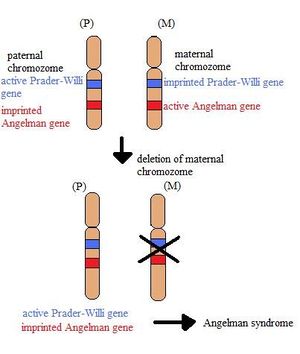Angelman Syndrome: Difference between revisions
From WikiLectures
(new dictionary, text was extracted from Genomic Imprinting, author is Garasone) |
m (inserted article) |
||
| Line 1: | Line 1: | ||
<!---------------------------------------------------------------------------------------------------------------- | |||
* INSERTED ARTICLE | |||
* Warning – this article is used in other articles where is inserted. If you are changing this article, you are changing other articles at the same moment. Please, be careful when you are editing it: | |||
* 1. Do not remove commands <noinclude> </noinclude>. These command usually mark which are not used in other articles, where is this article used. | |||
* 2. Do not change level of headings. | |||
* 3. Great expansion or removing of the text of the article can change the meaning of other articles. You can discuss all these changes on discussion page of this article. | |||
* All the articles, where is this article inserted can be found in ''Toolbox'' → ''What links here''. | |||
* | |||
* Please, do not remove this comment. If you are not sure, you can contact our [[WikiLectures:Editorial board | editorial board]]. | |||
* | |||
* This warning note is automatically inserted by inserting the template {{subst:Inserted article}}. | |||
-------------------------------------------------------------------------------------------------------------->[[Category:Inserted articles]] | |||
__NOTOC__<noinclude>{{Dictionary | __NOTOC__<noinclude>{{Dictionary | ||
|eng=Angelman syndrome}}</noinclude> | |eng=Angelman syndrome}}</noinclude> | ||
Revision as of 05:42, 6 August 2011
| English: Angelman syndrome |
- This syndrome is caused by the lost of function of gene UBE3A - just maternal copy of this gene is functional. Syndrome is result of the lost of maternal chromozome 15 segment. This genetic disorder is connected especially with the nervous system. Childrens are affected in their early age.
- Typical symptoms: developmetal delay, speech problems, ataxia, epilepsy or microcephaly.
- Pacients are sometimes called "happy puppets" because of their behavior. They frequent smile, laught and have flapping movements.
- Incidence of Angelman syndrome is 1 in 12 000 - 20 000 people worldwide.
Links
Related articles
Sources
Bibliography
- KUMAR, ABBAS, FAUSTO, MITCHELL,. Robbins Basic Pathology. 8th edition edition. 2007. ISBN 978-0-8089-2366-4.




